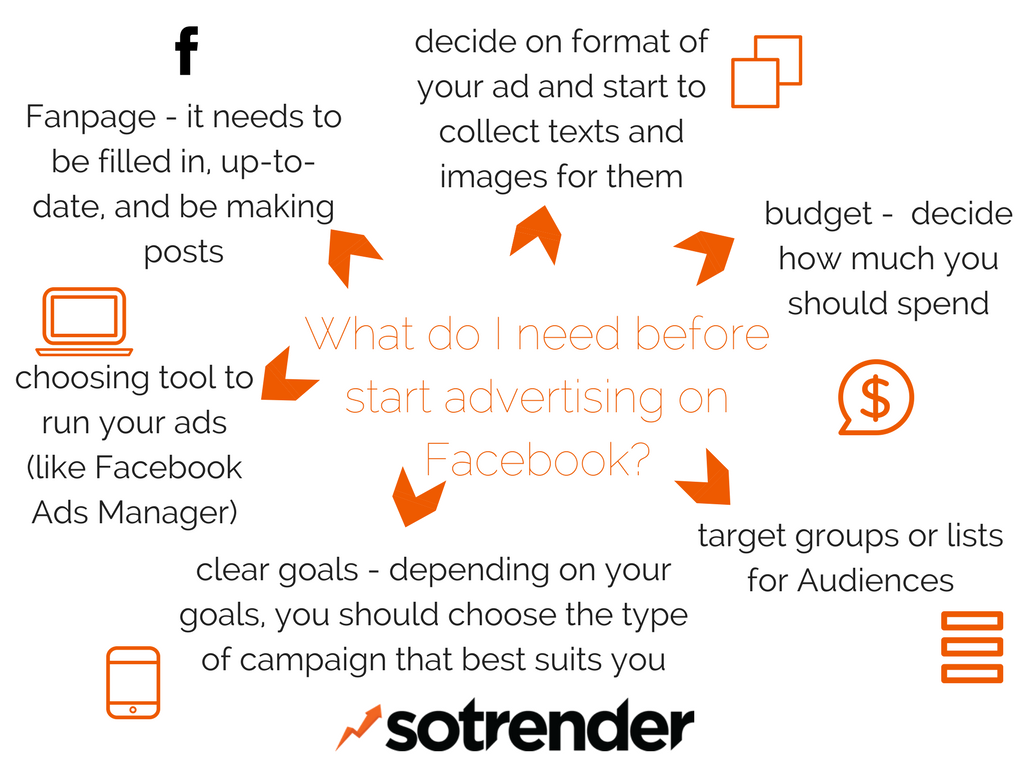If you want to post ads on Facebook, you should know it’s relatively easy. But it’s always better to prepare things in advance to make things smoother. We’ve prepared a list of things you’ll need to start advertising on Facebook in this post. Keep reading and you’ll see why these things are a necessary part of planning a strategy.
1. Fanpage
Facebook’s advertising system is thoroughly developed and you can choose from multiple ad formats. The format should be well-fitted to your goals. If you need help, Facebook is always giving you tips and guidelines on choosing the right one.
But to set your ads on Facebook, you need to have a Fanpage first. Of course, your Fanpage needs to be filled in, up-to-date, and be making posts (more on creating Fanpage here and here). Every ad will contain a clickable name of your Fanpage, which will drive users to your page.
2. Creatives
When you decide on the format of your ads, start to collect texts and images for them.
Ads should be eye-catching, interesting, and should contain a clear CTA. Users like to know what will happen after clicking your ad – make sure that this is clear to them.
Depending on the size of your campaign, you should start with at least a few different creatives. But be ready to update them or change them completely if the first batch underperforms.
3. Clear goals
Facebook offers a few objectives for your campaigns. Depending on your goals, you should choose the type of campaign that best suits you. And then you have to measure your KPI’s. You can choose from:
- Page Likes. When you want to build your Fanpage and gather new fans.
- Page Post Engagement. When you want to engage people with your posts.
- Click to Website. When you want to drive people to your landing page.
- Website Conversions. If your main goal is conversions, this is the option to choose.
- App Installs. When you’re promoting an app and you want people to install it.
- App Engagement. When you’re targeting people who have your app and you want them to engage more/again.
- Offer Claims. When you have a special offer and you want people to promote it.
- Local Awareness. When you want to target users near your business (please note that this may not be available in all countries).
- Event Responses. When you’re promoting an event.
- Video Views. When you want to engage people with your video content.
Start analyzing your Facebook performance
4. Specified target groups or lists for Audiences
Depending on your goals, your type of promoted product, and your type of business, you need to decide who you want to target with your ads. On top of your country/city, you can add other conditions such as age, gender, interests, marital status, education, or even their local area.
5. Budget
When you’re planning your first campaign on Facebook, it can be hard deciding how much you should spend. Every time-cost will vary based on the goals of your campaign, model of bidding, size of an audience that you want to target, competition in a specific period of time (for example ads around Christmas time will be most expensive) etc.
Facebook estimates the average cost while you’re setting your targeting in Ad Manager or Power Editor. If you can’t run a test campaign, we recommend relying on those estimations. But remember that it’s only an approximate value and the final cost can be different.
6. Choose payment method
There are a few different ways to start advertising on Facebook. If you want to manage campaigns on your own, the best option is to use Facebook Ads Manager. This is Facebook’s own tool, which is free and will charge you only for the cost of ads.
To use Ads Manager, it’s necessary to set up at least one of the available payment methods (note that these methods may change for some countries):
- credit card
- PayPal
- Mobile
- gift cards
For credit cards make sure to prepare all your standard details.
After preparing these important elements, you will be ready to go live with your first Facebook ads campaign.

Now, we should also mention, it’s really important that you regularly check your Facebook Ad analytics in Ads Manager or a similar tool. This is because the metrics featured there will tell you whether or not you’ve hit the right target, how engaging your ads are, and whether you met your goals. If you don’t know where your metrics are at, you can’t possibly be sure if your Facebook ads achieved what you wanted them to achieve.
Once you know more about your metrics and ad performance, you’ll know how to optimize Facebook ads later on. These are all important components that you’ll need to start advertising on Facebook effectively.



